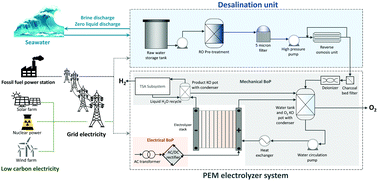Seawater electrolysis for hydrogen production: a solution looking for a problem?†
Abstract
As the price of renewable electricity continues to plummet, hydrogen (H2) production via water electrolysis is gaining momentum globally as a route to decarbonize our energy systems. The requirement of high purity water for electrolysis and the widespread availability of seawater have led to significant research efforts in developing direct seawater electrolysis technology for H2 production. In this perspective, we critically assess the broad-brush arguments on the research and development (R&D) needs for direct seawater electrolysis from energy, cost and environmental aspects. We focus in particular on a process consisting of seawater reverse osmosis (SWRO) coupled to proton exchange membrane (PEM) electrolysis. Our analysis reveals there are limited economic and environmental incentives of pursuing R&D on today's nascent direct seawater electrolysis technology. As commercial water electrolysis requires a significant amount of energy compared to SWRO, the capital and operating costs of SWRO are found to be negligible. This leads to an insignificant increase in levelized cost of H2 (<0.1 $ per kg H2) and CO2 emissions (<0.1%) from a SWRO-PEM coupled process. Our analysis poses the questions: what is the future promise of direct seawater electrolysis? With an urgent need to decarbonize our energy systems, should we consider realigning our research investments? We conclude with a forward-looking perspective on future R&D priorities in desalination and electrolysis technologies.

- This article is part of the themed collections: Energy Frontiers: Hydrogen and Energy and Environmental Science Recent Review Articles


 Please wait while we load your content...
Please wait while we load your content...